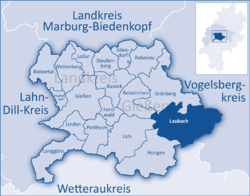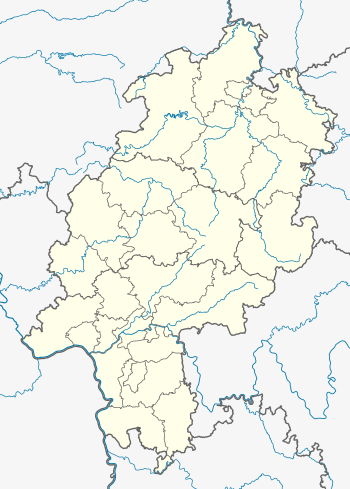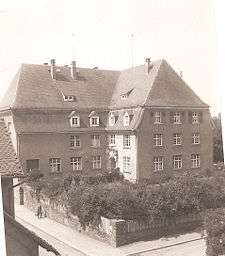Laubach
Laubach is a town of approximately 10,000 people in the Gießen region of Hesse, Germany. Laubach is known as a Luftkurort, a climatic health resort. It is situated 23 kilometres (14 mi) east of Gießen. Surrounding Laubach are the towns of Hungen, Grünberg, Schotten and Lich.
Laubach | |
|---|---|
 Coat of arms | |
Location of Laubach within Gießen district  | |
 Laubach  Laubach | |
| Coordinates: 50°32′N 08°59.4′E | |
| Country | Germany |
| State | Hesse |
| Admin. region | Gießen |
| District | Gießen |
| Government | |
| • Mayor | Peter Klug (Ind.) |
| Area | |
| • Total | 97.01 km2 (37.46 sq mi) |
| Highest elevation | 535 m (1,755 ft) |
| Lowest elevation | 230 m (750 ft) |
| Population (2018-12-31)[1] | |
| • Total | 9,583 |
| • Density | 99/km2 (260/sq mi) |
| Time zone | CET/CEST (UTC+1/+2) |
| Postal codes | 35321 |
| Dialling codes | 06405 |
| Vehicle registration | GI |
| Website | www |
Points of interest
The dense Laubach Woods spread into the foothills of the Vogelsberg Mountains. With its many historic and colorful half-timbered (fachwerk) buildings, Laubach is an area of interest to tourists.
The main point of attraction is the castle, which is still owned by the count of Solms-Laubach. It was built in the thirteenth century and expanded over the years. The Solms castle has one of the largest private libraries in Europe, with over 120,000 titles. An original Gutenberg Bible, on display in the Johann Gutenberg Museum in Mainz, came from this private collection. The castle grounds include a huge park with a swan lake, open to the public.
The city's Evangelical Lutheran Church, formerly named St. Maria, has a Baroque organ. The oldest part of the church was built in the twelfth century. It was renovated in the eighteenth century.
The former district courthouse (Amtsgericht), the city hall, and the Heimat Museum are together on the main street of Friedrichstrasse. The courthouse is now a residence for senior citizens.
The Heimat Museum–Fridericianum is the local history museum, originally built near the town of Gonterskirchen in 1750 by Count August Solms-Laubach. The building was moved to its present location in 1832 and served as a school before it became a museum. The museum contains a permanent exhibit of the diary of city resident Friedrich Kellner.
Notable residents
- Friedrich Kellner (1885–1970) - Laubach's chief justice inspector during World War II, he wrote a 10-volume diary about the misdeeds of the Nazis, later published as a book, My Opposition (German: Mein Widerstand). He became deputy mayor, first town councilman, and chairman of the regional branch of the Social Democrats. A Canadian documentary about Kellner was filmed on location in Laubach.
- Felix Klipstein (1880–1941), artist - grew up in Laubach and Belgium, spending his academic years in France and Spain, where he did special studies in Velázquez. In 1909 he settled in Laubach with his wife, the writer Edith Blass.
- Friedel Münch (1927–2014), head of Münch Motorcycle Works
- Philipp Erasmus Reich (1717–1787), bookseller and publisher
- Georg Friedrich Solms-Laubach (1899–1969)
- Sophie von Solms-Laubach (1594–1651)
- Countess Monika zu Solms-Laubach (1929–2015), Princess Consort of Hanover
Laubach in the media
Literature
- Nachtigall, Helmut (1975). Die Fachwerkhäuser Alt-Laubachs: Führer durch die Holzarchitektur Alt-Laubachs. Laubach.
Film
- My Opposition: The Diaries of Friedrich Kellner. Toronto, Canada: CCI Entertainment.
Gallery
 Sheep grazing, a part of Laubach's landscape
Sheep grazing, a part of Laubach's landscape Solms Castle and Laubach houses
Solms Castle and Laubach houses Laubach courthouse (Amtsgericht) in 1938
Laubach courthouse (Amtsgericht) in 1938 Chief Justice Inspector Friedrich Kellner (center), at the Laubach courthouse in 1948
Chief Justice Inspector Friedrich Kellner (center), at the Laubach courthouse in 1948 The ruined church "St. Valentin" of the deserted village Ruthardshausen, July 2007
The ruined church "St. Valentin" of the deserted village Ruthardshausen, July 2007
References
- "Bevölkerungsstand am 31.12.2018". Hessisches Statistisches Landesamt (in German). July 2019.
